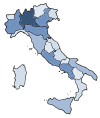An Italian Survey on Dietary Habits and Changes during the COVID-19 Lockdown
- PMID: 33916384
- PMCID: PMC8065756
- DOI: 10.3390/nu13041197
An Italian Survey on Dietary Habits and Changes during the COVID-19 Lockdown
Abstract
The World Health Organization has declared the coronavirus outbreak a Public Health Emergency of International Concern; the outbreak has led to lockdowns in several parts of the world, and sudden changes in people's lifestyles. This study explores the impact of the first coronavirus disease 2019 (COVID-19) pandemic period on dietary habits, lifestyle changes, and adherence to the Mediterranean diet among the Italian population, through an online questionnaire, conducted from April to May 2020, involving 1519 participants. The 14-point Mediterranean Diet Adherence Screener (MEDAS) highlighted a medium Mediterranean diet adherence in 73.5% of responders, which principally included the younger population, aged 18-30 years (p < 0.05). In regards to changes in eating habits, 33.5% of responders declared an influence of the pandemic period on nutritional practice. A decrease in alcohol consumption was reported by 81% of responders, while an increase in frozen food consumption was reported by 81.3% of responders. In addition, 58.8% reported positive weight modification (40.8%, +1-3 kg); physical activity reduction was reported for 70.5% of responders. Our study contributes toward amplifying the investigation on the dietary habits and changes of the Italian population during the COVID-19 lockdown, although the pandemic is ongoing. Similar studies should be performed around the world to understand how the emergency has impacted people's habits.
Keywords: COVID-19; MEDAS score; Mediterranean diet adherence; coronavirus; dietary habits and changes.
Conflict of interest statement
The authors declare no conflict of interest.
Figures



References
-
- Stoecklin S.B., Rolland P., Silue Y., Mailles A., Campese C., Simondon A., Mechain M., Meurice L., Nguyen M., Bassi C., et al. First cases of coronavirus disease 2019 (COVID-19) in France: Surveillance, investigations and control measures, January 2020. Eurosurveillance. 2020;25:2000094. - PMC - PubMed
-
- WHO . Coronavirus Disease (COVID-19) Pandemic. WHO; Geneva, Switzerland: 2019. [(accessed on 12 February 2021)]. Available online: https://www.who.int/emergencies/diseases/novel-coronavirus-2019?adgroups....
MeSH terms
LinkOut - more resources
Full Text Sources
Other Literature Sources
Medical
Miscellaneous

